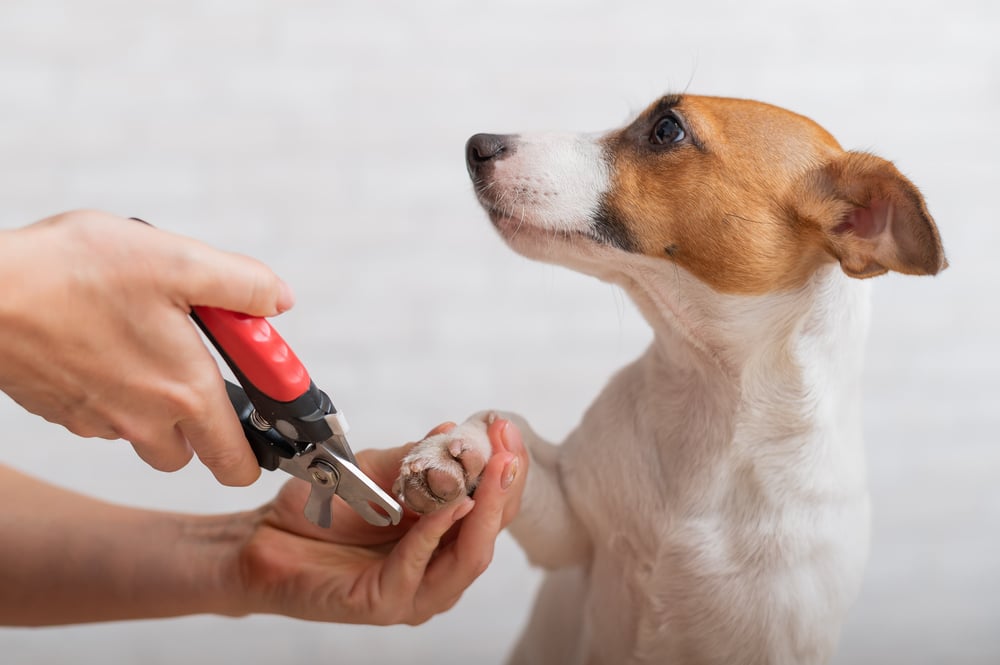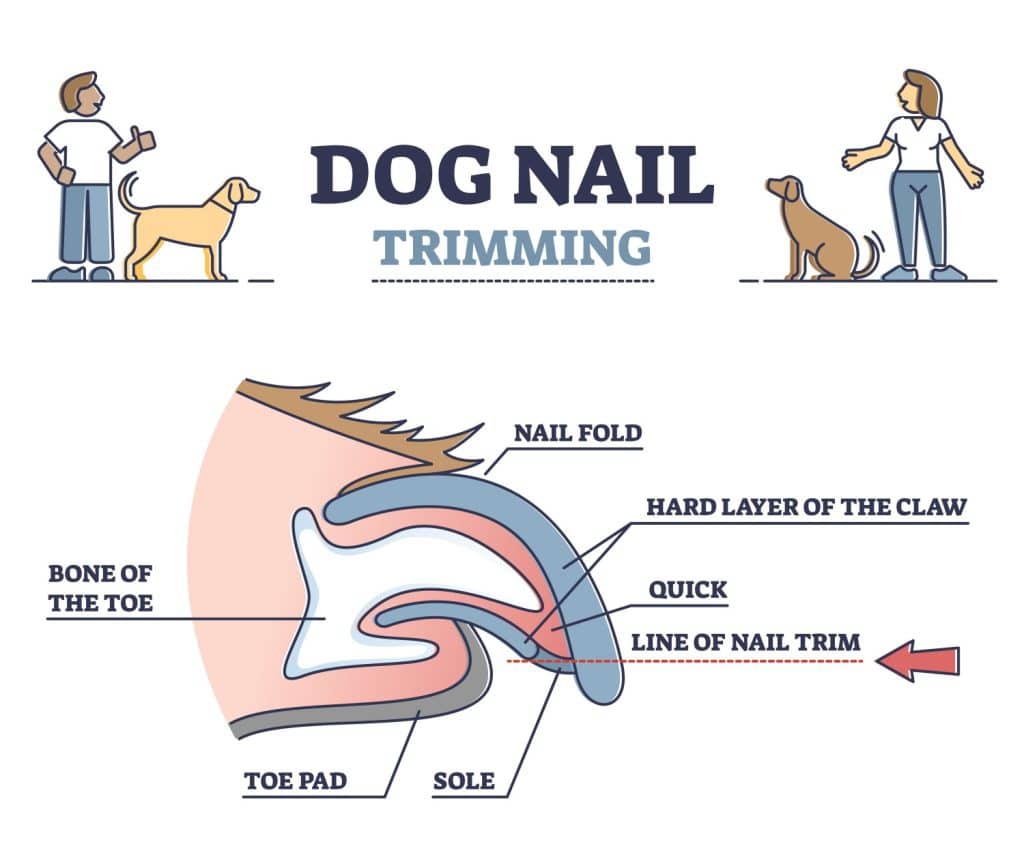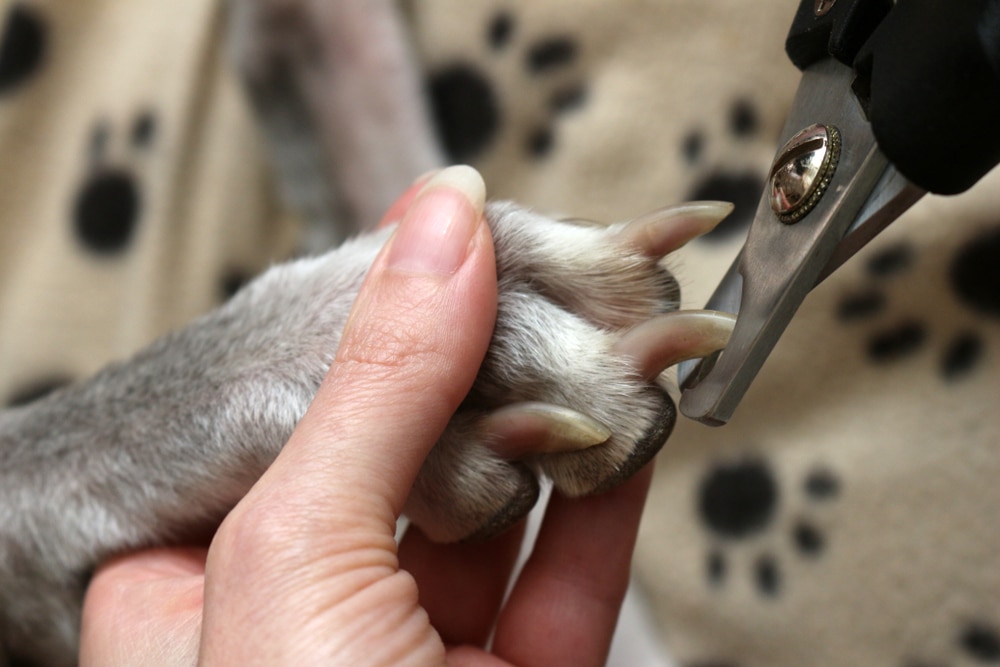Outdoor dogs and their wild cousins rarely encounter the issue of overgrown nails because their nails are constantly worn down as they run and play. However, dogs that are less active and spend a lot of time indoors may need regular trims to keep their nails in check. If you’ve never heard of the practice you may wonder, “is it safe to clip a dog’s toenails?”
Yes, it is safe to clip a dog’s toenails! When done properly, regular nail trims will help keep your dog comfortable and prevent breakage, infections, and discomfort. If the tip of your dog’s nails is touching the ground, use an appropriate clipper to cut the nail straight across. Make sure not to clip the quick (a pink, fleshy triangle that grows in the nail bed), but this can be harder to do for dogs with black toenails!
Table of Contents
Some Quick Facts About Clipping A Dog’s Toenails

Dogs need their toenails clipped. It’s a part of taking care of them. If you don’t know why this is so important though, let’s go over a few facts
How Fast Do A Dog’s Toenails Grow?
The speed at which your dog’s nails grow can vary depending on many factors including but not limited to age, body weight, activity level, nutrition, and underlying illnesses. No two dogs are the same in their nail growth, and you will want to check each one diligently and trim them as needed.
How Often Should You Cut A Dog’s Toenails?
Because different dogs have such different rates of toenail growth, regular assessment is important to ensure your dog is comfortable. A good rule of thumb is to cut a dog’s nails once they touch the floor – if Brody is running around making tippy-tap sounds on the hardwood floors, it’s time for a trim!
For dogs with overgrown nails, the quick will have advanced well into the nail. That is the pink fleshy triangle that you can see growing from the nail bed. It contains blood vessels and many nerve endings; cutting through it is a painful and traumatic experience for any dog and will make them averse to nail trims in the future. In these cases, more frequent trims will be necessary to gradually shave off small portions of the nail as the quick regresses.
What Happens If You Don’t Clip A Dog’s Toenails Regularly?
Overgrown toenails are uncomfortable for your pet. Long nails that push into the floor can put backward pressure on the nail bed and the toe joints. In addition to being painful, this can eventually lead to arthritis and nerve injuries as well as posture abnormalities.
Nails that are too long are also prone to breakage. A broken toenail provides an ideal passage for the entrance of bacteria.
Also, you can easily overlook the nail on the dewclaw, that is the toe that sits higher up on the foot than the others. This can continue to grow and curve inward until it begins to dig into the skin. These ingrown nails are also common sites for infection. Dogs can have dewclaws on both their front and back feet.
Paw and nail injuries in dogs are notoriously difficult to treat. So in this case, prevention is definitely better than cure!
Some dogs are more sensitive to pain than others as well. Discomfort from overgrown nails can cause them to lick and chew their feet excessively, leading to trauma and moist skin infection.
How To Safely Clip A Dog’s Toenails?
It is extremely important to clip a dog’s toenails in a safe way. If a dog associates an activity with pain, it will be very difficult to get them to do it again. The first step in avoiding this is knowing the anatomy of a dog’s paw.
Anatomy Of A Paw: The Nails, The Quick, And How To Identify Them

Dogs typically have eighteen toes with their associated toenails. Five on each front foot and four on each of the hindlegs. Some dogs have extra toes due to a condition known as polydactyly.
The nail on each toe has an insensitive portion made up of keratin, the non-living material found in human hair and fingernails. The middle portion, known as the quick, is rich in blood vessels and nerves and provides nourishment and sensation to the nail.
On dogs with light-colored toenails, the quick is easily identifiable as a faint pink triangle in the center of the nail. Make sure not to cut the quick to prevent bleeding.
In black-nailed dogs, the quick is not readily visible and small slivers of the nail should gradually be snipped off to avoid cutting right through it. I like to hold a flashlight under the nail to help me identify where to cut.
Tools: Types Of Nail Clippers/Trimmers/Grinders/Pads/Etc.
Choosing the right tool is essential to creating a hassle-free “manicure” experience for your pup. The “scissor-type” nail clippers for dogs are designed to provide a smooth cut. I tend to avoid the “guillotine-type” ones because these crush the nail and make it harder to see the quick. Smaller clippers provide better control and if you’re left-handed, using a clipper designed for lefties will may your task way easier!
If your dog hates the loud snap of a clipper, another option is to use a nail grinder. Make sure to get a quiet grinder with adjustable speeds so you can slowly acclimate your pup to the sound before actually using it on them. The sounds and sensations will be very foreign so have patience while your dog gets accustomed to the process! Remember to only grind the nail for 2-3 seconds at a time to avoid overheating and make sure to hold any long fur away so that it doesn’t get tangled up.
Nail boards, either bought or handmade, are a great alternative for dogs that hate having their paws touched. Dogs can be conditioned to use a nail board in the same way they are taught to wipe their feet on a carpet. Dr. Christine Calder provides a great guide here.
When you’ve exhausted all your options, these slings are a great option for uncooperative pups.
Just make sure to give lots of treats and praise and introduce the experience gradually, to avoid forming a negative connection that will cause your dog to run away at the sight of the sling and trimmers.
What To Do If The Nail Is Overgrown?
If the nail has been left untrimmed and has grown very long, it’s likely that the quick has grown deep into the nail bed. Avoid cutting a large chunk off the nail. Instead, cut small slivers off the nail more regularly, up to once a week. This will encourage the quick to regress, allowing you to cut a little bit more the next time.
If the nail has grown into the toe, have your veterinarian clip the nail and examine the wound. Your pup may require regular wound cleaning to control potential infections.
How To Manage Bleeding?
Clipping the quick can cause substantial bleeding. If this occurs, remain calm! Reassure your dog to avert the formation of a negative association. Then use styptic powder or cornstarch on a piece of gauze to apply pressure to the nail.
Creating A Positive Association Between Your Dog And Clipping Its Toenails
This is an essential part of successfully cutting your dog’s toenails. If you ever want to do it again, you’ll need to make sure a positive association is formed between your dog and cutting its toenails as soon as possible.
For Puppies
Nail trims can be a pretty traumatic experience for an unconditioned dog. During puppyhood, it is important to train your pup to learn to love nail trimming sessions. You can do this with food treats and lots of praise. Keep training sessions short by only clipping one or two nails a day. If your puppy is averse to having its paws touched, incorporate paw-holding into play time before ever introducing the clipper.
It is important to never allow the puppy to associate their “manicures” with a negative experience. Do not shout at an uncooperative puppy and force them into having their paws handled and clipped. And definitely avoid accidentally cutting the quick and causing pain.
For Adult Dogs
For adult dogs that are afraid of nail trims, food rewards are the key to creating a positive experience. The secret is to change the emotion around the experience of nail trims. That will eventually lead to a change in behavior. The goal is to encourage the dog to understand that nail trims mean treats. To do this, give treats at every stage of the process. Here are some examples:
- If your dog allows you to touch its paw, give your dog a treat.
- If your dog allows you to pick it up and hold it, give your dog a treat.
- If your dog allows you to touch the clipper to the nail, give your dog a treat.
- If your dog maintains its attention with the sound of the snip or grinder nearby, give your dog a treat.
- If your dog allows you to clip a nail, give your dog a treat and lots of praise.
As your dog gets better at this, you can slowly reduce the number of treats until you’re only treating after each clip or even after clipping all the nails on one paw.
For dogs that are neutral to nail trims, just a good old-fashioned distraction such as having someone else feed creamy treats while you trim their nails may be enough. If you’re alone, you could try smearing it on your forehead instead.
In Conclusion: It Is Safe And Necessary To Clip Your Dog’s Toenails!
As our dogs’ primary caregivers, it is our responsibility to ensure they are comfortable and happy. Since we’ve raised them for a more sedentary life indoors, where they cannot naturally wear out their nails, regular trims are necessary for their well-being. Whether at home or at the vet, make sure you check your dog’s nails at least once every fortnight and clip them when needed.
